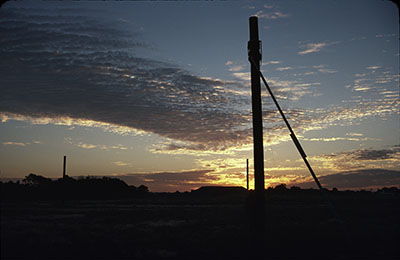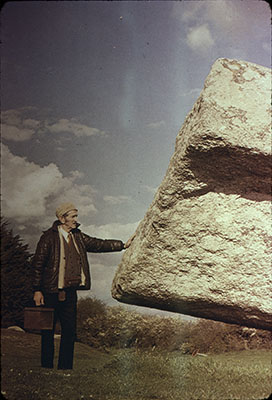June 6, 2024
Intro
I am in the midst of a project to scan all of my father's (Michael's) 35mm slides (current estimate: some 4500 of them).
I have been pretty careful to scan the slides in the same groups in which I found them in the myriad boxes I have. Recently, I came across a handful of slides developed in June 1979 of sunrise at Cahokia Mounds. These images (one shown below) show the alignment of the then recently-reconstructed Woodhenge posts with the edge of Monks Mound, a half mile away. This photo was most likely taken at the March 1979 spring Equinox (despite the June development date).
OK, that's fine, as Michael had a long-standing professional interest in the archaeoastronomy Cahokia represented.
However, in the middle of this group of slides was the curious image shown below, of a man with a leather satchel and a leather camera case around his neck reaching out to touch a huge rock. The slide was marked with a development date of April 1978. There were no additional hand-written notes on the cardboard slide mount.
What the heck was this image and why was it mixed in with the Cahokia shots?
These two images can be clicked upon to see them larger.
The Challenge
What would I be able to learn about this image and its connection to the Cahokia ones, if any?The Sleuthing
The person was not anyone I recognized, as a starting point. But with the style of clothes and accessories, it was not a particularly recent photo (although it being color placed a rough early bound of around 1950).
I did notice that when I zoomed into the image, I could see tell-tale hexagons of offset printing, and I surmised it might have been a photograph of a postcard.

Next I turned to Google Image Search (images.google.com). I did a drag and drop of the photo onto the site. I expected to find numerous hits and these would help me refine my search. Nope! Instead, there was a single hit, as shown below:
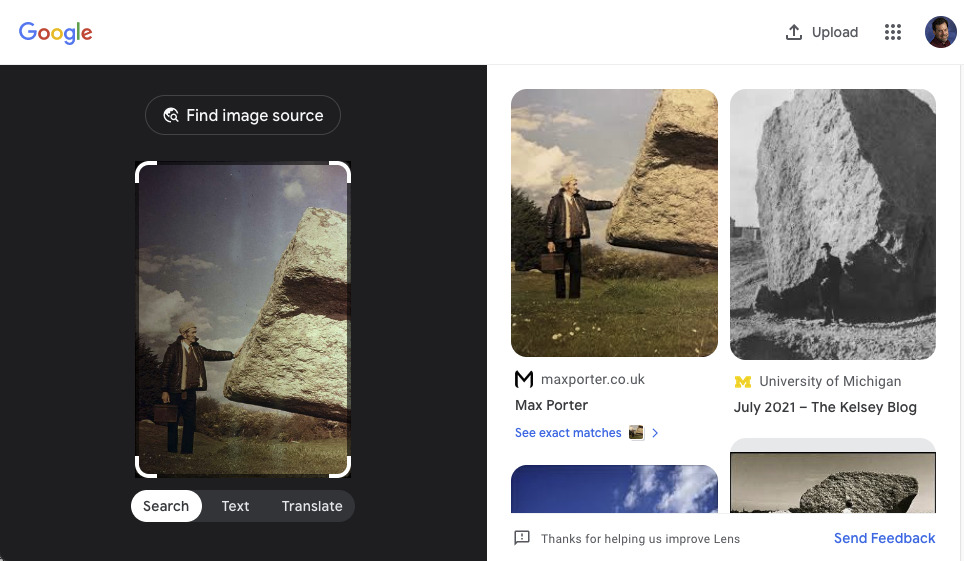
So, there were lots of pictures of individuals next to large rocks, but only one of this exact photo. How odd!
(You can reproduce the search I did from this link.)
When I clicked on it, it took me to www.maxporter.co.uk, the web site of British author Max Porter. Not only that, but it was the main page of his site, and it was the only image on this page, shown in a very large circle. Control-clicking (right-clicking) on the image in the browser and selecting "open image in new tab" showed it was indeed a rectangular image, slightly differently cropped from the slide I was working from but totally clear that it was the same image.
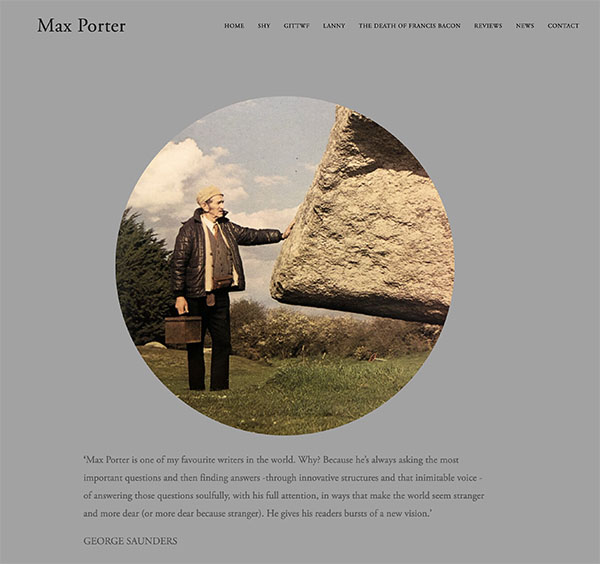
More mystery!
Now I was perhaps even more perplexed! A single hit for this image showed up on the page of this British author, born in 1981 (as documented on his Wikipedia page), for a slide for which Michael had photographed this image in April 1978!
At that point, I clicked on the Contact link of the Max Porter web site and found not his email address, but that of his agent Lisa Baker of a London-based firm. I wrote to her in mid-May, 2024.
Solving the puzzle
She graciously wrote back in just a few days to say:This was an extremely fun email to receive!Quoted with permission of Lisa Baker.
Max has managed to find the book this is from – pics below. [...]
As for the reason, Max is very fond of neolithic/esoteric books and pictures such as these – much of his writing has roots in a desire for or exploration of a more ancient understanding of our world.
I hope that all helps.
She also included two attachments in her message, as shown below. I assume that Mr. Porter took these images himself from his copy of the book and forwarded them to her:
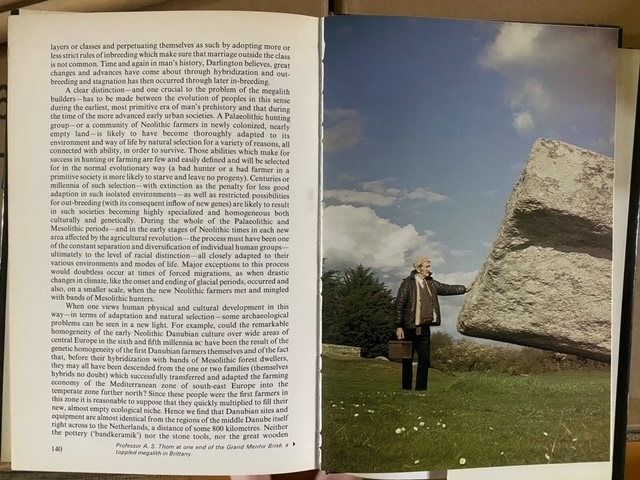

Image identity
Thus it was page 141 of The Megalith Builders by Euan MacKie. A caption at the bottom of page 140 reads:
Professor A.S. Thom at one end of the Grand Menhir Brisé, a toppled megalith in Brittany.
The connection back to Michael
In 2022, when my mother made the decision to move out of the house my parents bought in the 1960s, we donated all his books (nearly 1100) to the Washington University Physics Department Library. I wanted to catalog his collection before they were gone, so I used the Library Thing iPhone app (iOS App Store link) and web site for doing so.
I have a pretty good visual memory, so when I saw the book cover photo of "The Megalith Builders" Lisa Baker had
sent, I immediately recognized it, among the many titles on archaeoastronomy in his collection. Then I verified
it in the Library Thing database for him:
books about megaliths in Michael's
collection
It's a pretty obscure book -- only 43 LibraryThing users have it in their entered collections!
One other interesting note is that the above link to LibraryThing, searching for "megaliths" in Michael's collection actually shows three other books by Alexander Thom, which may underscore Michael's interest in finding an unusual photo of Thom himself.
So, I wasn't quite right—my dad did not photograph the image from a postcard, but from a full-page illustration in the book, which he already owned. The Amazon entry for this book show that the book was published in January, 1977. Since his slide was dated April 1978, it must indicate that he bought the book soon after it came out and then at some point decided to photograph this book plate to use in his own lectures. (I could find no evidence that it was ever included in any of Michael's own authored books.) And Euan MacKie must have thought it an important image to include in his book, as full-page color, in an era when color plates were expensive to incorporate.
More about the image
While I was at it, I decided to learn more, since I now had a precise caption.
Professor A.S. Thom (1894-1985) has his own Wikipedia page, as it turns out. Furthermore, he dedicated decades of his life to archaeastronomy, specifically the stone circles of the U.K. and Stonehenge.
I was not familiar with the Grand Menhir Brisé. It is located near the town of Locmariaquer in Brittany in northwest France. It was apparently erected around 4500BC and has a fascinating history (Wikipedia; ancient-wisdom.com, among many others)
I learned more about it from an article at megalithic.co.uk. From photos on this site and other sites, one can clearly see the largest stone, one end of which is in mid-air, as shown in the older photo with Professor Thom.
Here's a map showing the four rocks of the Grand Menhir Brisé. (Click the "+" to zoom in to get a clear view of the rocks) :
Conclusion
Again, this is not a photograph by Michael, just a picture of a picture. But at least I now know why this slide was kept and stored with the Cahokia ones!
My thanks once again to Lisa Baker and Max Porter for helping me solve this mystery!
